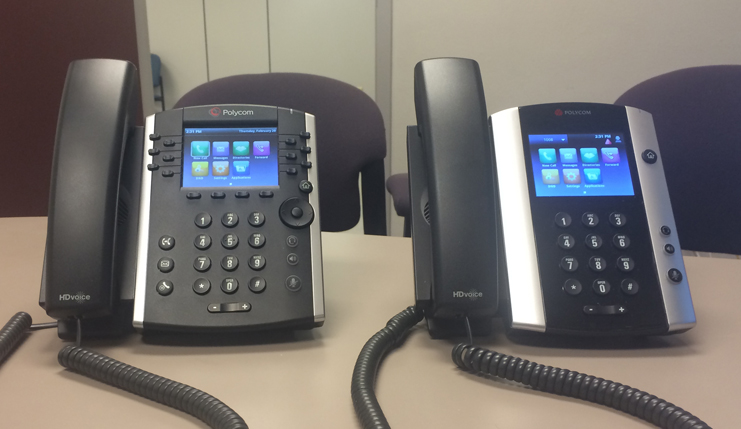The University of Virginia is getting new phones – about 20,000 of them.
As noted in the recent email to employees from Pat Hogan, U.Va.’s executive vice president and chief operating officer, the current telephone system at U.Va. – most of which is now nearly two decades old – will soon be replaced with a more modern telephone system based on VoIP (Voice over Internet Protocol) technology, in partnership with a vendor named Broadsoft.
Telephone line migration and phone replacement is set to begin on the academic side of the University in June, and on the Medical Center side in September. This phase of the project will take about 16 months.
Once the migration is complete, U.Va. faculty and staff will find that the new phone system offers numerous new features and advantages:
- State-of-the-art telephones with HD-quality sound, enhanced speakerphone capabilities, and a history feature showing missed, received and placed calls;
- Enhanced caller ID for calls coming into the University;
- A new voicemail system to replace the current Xpressions system;
- Voicemail via email with an attached audio file;
- Long-distance calls without FAC code requirements (some exceptions apply);
- Multiple concurrent calls with a single telephone line;
- Speed dial, voicemail options and call forwarding via a new phone management website;
- Future integration with Exchange email and Microsoft Lync.
In addition, some things will stay the same: existing U.Va. telephone numbers will be retained, as will the ability to use the abbreviated five-digit dialing sequence when on Grounds.
Preparing the University’s Network for VoIP & More
According to Virginia Evans, U.Va.’s chief information officer and the executive sponsor of the phone replacement project, “Because the new telephones will run on the same network as our computers, we laid the groundwork for VoIP by improving the network infrastructure of buildings around Grounds and by upgrading the University’s core data network.”
Those upgrades increased the network’s redundancy and reliability and put in place the capability to support speeds 10 times greater than today.
In addition to preparing the wired Ethernet network for VoIP, the data network enhancements completed last fall will also facilitate the University’s many data-intensive research projects, the work of the new Data Science Institute and will support significant improvements to the reliability and bandwidth of the “Wi-Fi” available across Grounds.
“The new VoIP system will bring greater efficiency and ease of use to our community, and these are just the kind of results we are striving for as we move down the path toward organizational excellence,” Evans said.
Planning for Large-Scale Transition
By the time U.Va. has completed the transition to VoIP, it will have taken approximately three years to design a system to meet the University’s needs and then coordinate, plan and execute the transition and replacement of about 20,000 existing digital lines and phones, plus the transition of 6,000 more analog lines (supporting fax machines, emergency phone stations, elevator telephones, patient phones in the hospital, etc.).
A VoIP project steering committee with representatives from across U.Va. first convened in April and meets monthly to provide oversight for the project. In December, business units designated Departmental Telephone Representatives, who will act as liaisons between the VoIP project team and faculty and staff in University departments. The representatives will ensure that each U.Va. employee receives the appropriate phone for his or her needs and will verify critical telephone information to ensure accurate records during this time of transition.
When Do I Get My New Phone?
Changeovers to VoIP will be phased around Grounds, occurring building by building. Areas will be grouped together as much as possible by location to aid in the decommissioning of the older telephone switching equipment.
Roughly 60 business days in advance of an area changing over to the new system, the local representative will begin verifying and collecting critical data, including the specific phone model selection that will go on each employee’s desk.
Then, about two weeks ahead of each location’s changeover date, faculty and staff in that area will see their new VoIP telephones, but the phones won’t be working yet. Current phones will continue to be used until the night of each area’s changeover. The next morning, that group’s new VoIP phones will be fully functional.
The phones will come with a “Quick Start” brochure, and additional training will be available online.
While the VoIP Cutover Schedule by Building has not yet been released, it is expected to be available soon. Departmental Telephone Representatives will have more information for their respective areas once that area’s cutover date has been announced.
To learn more, visit the U.Va. VoIP website and be sure to check out pictures and descriptions of the new phones.
Media Contact
Article Information
February 25, 2014
/content/upgrade-20000-new-high-tech-phones-way-starting-june

